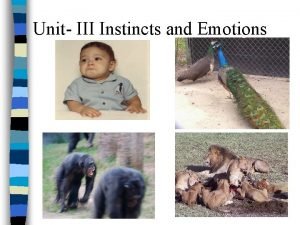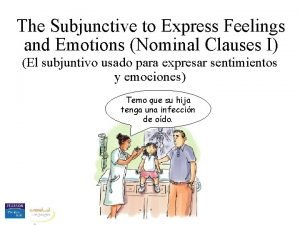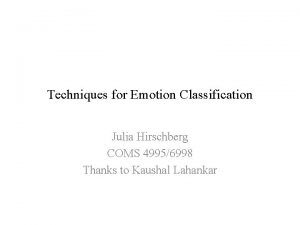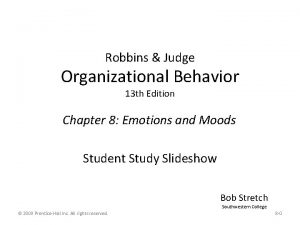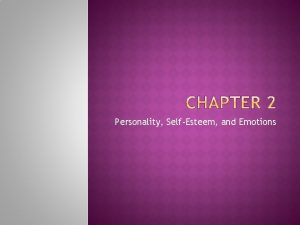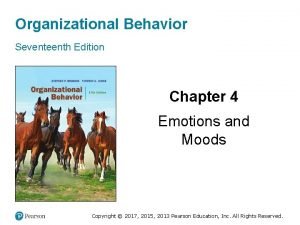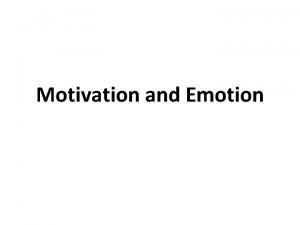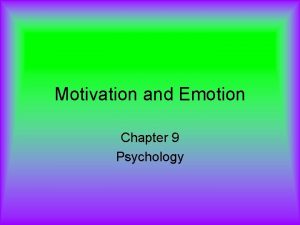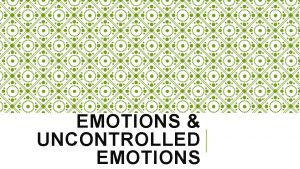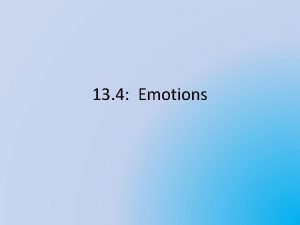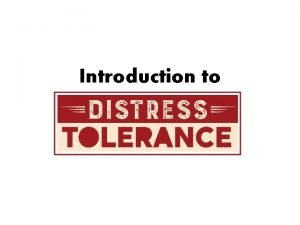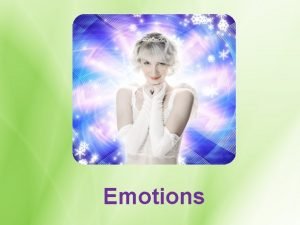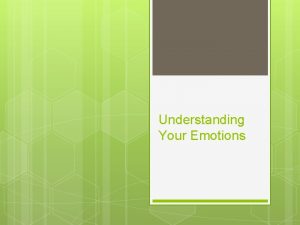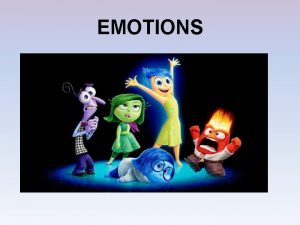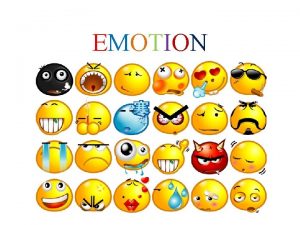Emotion Emotion Why do we have emotions Reproduction
















- Slides: 16

Emotion

Emotion Why do we have emotions? » Reproduction (e. g. , lust, love) » Self-protection (e. g. , anger & fear) » Social structure (e. g. , love, liking) Three major elements: » Physiological » Cognitive » Cultural

Physiological Common Sense View » Event -> Emotion -> Physiological response James-Lange Theory » Event -> Physiological response -> Emotion » “We feel sorry because we cry, angry because we strike, afraid because we tremble (W. James, 1884). ”

The Face of Emotion Six basic facial expressions: anger, happiness, fear, surprise, disgust, and sadness. Recognized across cultures with high reliability. Consensus highest for happiness, lowest for fear. Some context dependence. Probably used for communication, both to others and to ourselves.


Emotion & The Brain Amygdala » Evaluates sensory information for emotional importance; approach vs. avoid assessment. » Damage causes emotional abnormalities. Cerebral Cortex » “Rational” appraisal Some hemispheric specialization » RH: Recognition of emotional expression

Energy of Emotion Medulla releases epinephrine & norepinephrine Leads to state of arousal, the sine qua non of emotion. General vs. specific arousal?

Can lies be detected? Even very experienced professionals are no better than chance at detecting whether someone is lying. Problem with lie detectors: » No physiological patterns of responses are specific to lying. » Interpretation is unreliable » More likely to accuse the innocent than to release the guilty

Cognitive Two-factor Theory of Emotion » Event -> Physiological response -> Cognitive interpretation -> Emotions may be more closely associated with explanations than with outcomes (e. g. , good vs. bad performance on exams) Olympic medallists

Loneliness & Depression Who are the loneliest people in the US according to surveys? Three aspects of cognition are important in loneliness & depression: » Internality: Internal vs. external causes? » Stability: Permanent vs. temporary? » Control: Out of control vs. in control?

Loneliness & Depression Depressed or anxious people can learn how thinking affects emotions and change their thinking accordingly. Gillham et al. (1995) » 69 5 th & 6 th grade children at risk for depression. » Prevention group was taught to identify pessimistic beliefs; to examine evidence for and against beliefs; to generate more realistic alternatives. Control group received no training.

“Inoculation” Against Depression

The Culture Primary-Secondary Emotions » Primary are experienced universally – fear, anger, sadness, happiness, surprise, disgust, & contempt » Secondary are culture specific – Germans: schadenfreude (joy at another’s misfortune) – Japan: ijirashii (the feeling associated with an admirable person overcoming an obstacle) – Czech: litost (“a state of torment caused by the sudden insight into one’s own miserable self, ” Kundera)

The Culture ´Primary emotions » Physiological patterns » Facial expressions » Prototypes » Tend to be evoked by the same situations across cultures

The Culture Display rules Emotion work » Hiding emotions we feel, and showing emotions we do not feel. – Women: “flight attendants” – Men: “bill collectors”

Summary Emotions have three elements: Physiological, cognitive, & cultural. A relatively small number of emotions seem to be common to all cultures. The experience of emotion is affected by cognition and culture.
 Andreas carlsson bye bye bye
Andreas carlsson bye bye bye Binary fission in bacteria
Binary fission in bacteria Hare lynx
Hare lynx Asexual vs sexual venn diagram
Asexual vs sexual venn diagram 6 rectangular faces 12 edges 8 vertices
6 rectangular faces 12 edges 8 vertices Dont ask
Dont ask Why is asexual reproduction beneficial
Why is asexual reproduction beneficial Mcdougall theory of emotion
Mcdougall theory of emotion Padecer present subjunctive
Padecer present subjunctive Tangled ball of emotions
Tangled ball of emotions Deployment cycle of emotions
Deployment cycle of emotions Emotions classification
Emotions classification Emotions and moods in organizational behavior
Emotions and moods in organizational behavior Personality self esteem and emotions
Personality self esteem and emotions Emotions and moods in organizational behavior
Emotions and moods in organizational behavior Examples of physiological arousal
Examples of physiological arousal Example of motivation
Example of motivation







